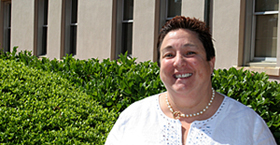Spanish Professor Unites Art and Research
April 4, 2011
11-72
Spanish Professor Unites Art and Research

|
VALDOSTA -- Dr. Miryam Espinosa-Dulanto speaks in colors and
photographs. With English as her second language, the Spanish
professor blends art and research to communicate in the academic
world.
“Sometimes it is difficult to express in words, the feelings raised
by discussions on certain issues such as, immigration, slavery or
world customs and cultures, so I encourage students to explore
other methods of communication to sharing their feelings and
findings,” said, Espinosa-Dulanto, whose office is lined with
vibrant photo essays on different themes from child slavery, to
love and family."
Espinosa-Dulanto dedicates much of herself to bridging cultures
through language and art. Within the Department of Modern and
Classical Languages, she coordinates the newly established Spanish
for Professionals, a Quality Enhancement Plan designed to improve
the Spanish-speaking skills of nurses, law enforcement officers,
businesses owners and other professionals who regularly communicate
with Spanish speakers.
Many of these students volunteer their time to work at the Migrant
Farmworkers Clinic, which provides support groups, legal resources,
medical aid, basic necessities and education to migrant workers in
the region. In early March, the clinic recognized Espinosa-Dulanto
and Dr. Tracy Woodard Meyers, director of the Women’s and Gender
Studies Program, for their contributions to the rural outreach
program.
“I have been working with the region’s migrant population for the
past two years. I go to the clinic about three times each week,
helping with everything from women’s groups to legal education.
Some situations are so desperate, and I could let myself get
depressed, but on the weekends, my students and I teach language
classes to the most hopeful bunch of people. They go to great
lengths to travel to the class and work so hard to become
productive members of society. There is light at the end of the
tunnel.”
Education in the Borderlands
The proud grandmother also teaches field research courses to
prepare students for the Borderland Cultural Immersion Experience,
an interdisciplinary, experience-based program that introduces
undergraduate and graduate students to life along the borderlands.
About 25 students will participate in the 2011 experience, which
will be held May 12 -- June 3 in El Paso, Texas and Juarez,
Mexico.
“It is amazing to watch students transform once they open
themselves up to these issues and people,” she said. “Not all of
them have the same views, but they realize how much they have to be
grateful for when they see a man working 12-14 hour days to send
all his money to Guatemala or a single mother struggling to feed
her baby. They start to become connected with the world in a very
human way.”
Espinosa-Dulanto, who recently traveled to a photo essay conference
in California, said she plans to incorporate an artistic research
project into the borderland experience, which is organized through
the Women’s and Gender Studies Program with input from the
departments of Sociology, Anthropology and Criminal Justice as well
as Modern and Classical Languages.
“Some of the student participants are not fluent, and they are
reluctant to communicate on the trip or after because they are
afraid they will say the wrong thing or not express themselves
fully,” Espinosa-Dulanto said. “The freedom to speak through other
means, such as artwork or photographs, gives students an outlet to
communicate with each other and break through cultural
barriers.”
For more information about the immersion experience, go to
www.valdosta.edu/womenstudies/U.S.-MexicoBorderIssuesCourses.shtml.
E-mail Espinosa-Dulanto at meespinosadulant@valdosta.edu
to learn more about her work.
Newsroom
- Office of Communications Powell Hall West, Suite 1120
-
Mailing Address
1500 N. Patterson St.
Valdosta, GA 31698 - General VSU Information
- Phone: 229.333.5800
- Office of Communications
- Phone: 229.333.2163
- Phone: 229.333.5983